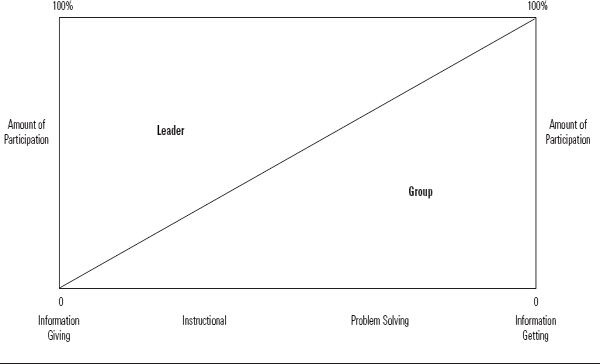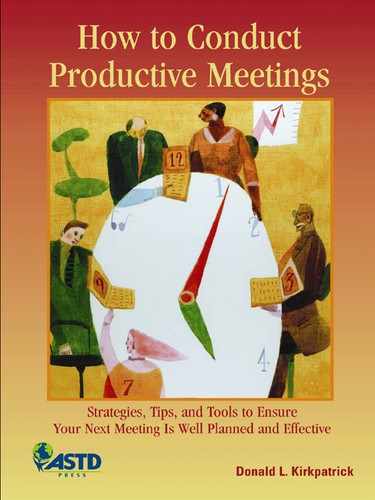Chapter 5
The Role of the Leader
![]()
Item 14 of the pretest states, “A meeting leader is more effective as a catalyst than a strong leader.”
Your answer will depend on your interpretation of “catalyst” and “strong leader.” To answer the question, take a look at the role of the leader in different types of meetings, as shown in figure 5-1.
Information-Giving Meeting
In this type of meeting, the role of the leader is to communicate the information so that the group understands. Figure 5-1 shows that a meeting might be 100 percent participation by the leader and 0 percent by the group. In other words, the leader does all the talking. Questions from the group might alter participation to 90 percent by the leader and 10 percent by the group.
Instructional Meeting
The role of the leader is one of teacher. The percentage of participation would depend on subject, objectives, and the knowledge and experience of the group, as well as on the personal style of the leader. For example, if the leader is an effective lecturer (speaker, presenter, etc.) and the group has little knowledge of the subject, the percentage may be 75-90 percent leader and 25-10 percent group.
If the leader prefers discussion, case studies, and management games, the figures may be evenly split, even if the group knows little about the subject.
If the group is knowledgeable in the subject, the leader may be 20 percent with 80 percent of the participation coming from the group.
Figure 5-1. Participation Chart.

Problem-Solving Meeting
The leader's challenge is to guide the group in the best solution to the problem. In this kind of meeting, the leader would accomplish the following tasks:
![]() Present information (that is, a statement of the problem, why it is important to solve, and background information).
Present information (that is, a statement of the problem, why it is important to solve, and background information).
![]() Get all members of the group to participate in solving the problem.
Get all members of the group to participate in solving the problem.
![]() Present ideas that will be considered in solving the problem (the leader steps down from the leadership role and becomes an equal member of the group).
Present ideas that will be considered in solving the problem (the leader steps down from the leadership role and becomes an equal member of the group).
![]() Control the meeting so that it moves toward the accomplishment of the objective, with minimum loss of time, friction, conflict, and antagonism among the participants.
Control the meeting so that it moves toward the accomplishment of the objective, with minimum loss of time, friction, conflict, and antagonism among the participants.
![]() Conclude the meeting with a summary of what was accomplished and what happens next.
Conclude the meeting with a summary of what was accomplished and what happens next.
The ratio for participation should be somewhere between 40-60 percent leader and 60-40 percent group.
Information-Getting Meeting
This kind of meeting requires an entirely different role by the leader. The leader must get attention and clarify objectives. In addition, the leader may provide some background information. The leader would probably participate 10-20 percent while the group dominates with 90-80 percent participation. The role of the leader is to get the group to participate and control the participation to accomplish the objective.
The role of the leader can vary dramatically. Sometimes, the role varies within the same meeting. For example, in a problem-solving meeting, the role includes presenter, stimulator, participant, and controller.
Now, look at the statement that began this section: “A meeting leader is more effective as a catalyst than a strong leader.” Webster's defines catalyst as “substance that accelerates a reaction and is unchanged in the process.” Based on this definition, the role of catalyst is appropriate in certain meetings and entirely inappropriate in others. It is appropriate for information-getting and brainstorming meetings and in some sections of problem-solving and instructional meetings. It is inappropriate in informational meetings and some parts of problem-solving and instructional meetings.
If we ask various people to define strong leader, we will get many answers. Some people look at this as a negative term that means “domineering,” “authoritarian,” “arrogant,” “bull of the woods,” and “dictatorial.” I consider it a positive term that connotes “control” and “flexibility.” A strong leader is necessary to keep the meeting productive, which is to accomplish objectives in minimum time with satisfied participants. The leader must know when to lecture, dominate, and be the authority. The leader must also know when to serve in the role of catalyst, stimulator, and listener. Table 5-1 summarizes the role of the leader in each type of meeting.
Table 5-1. The Role of a Leader.

